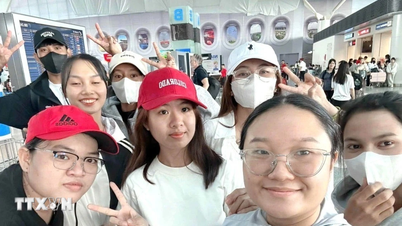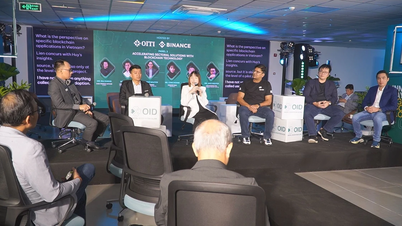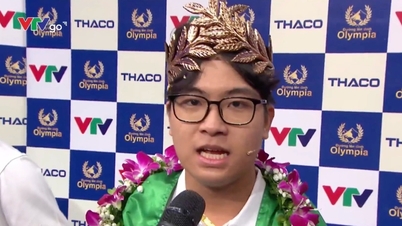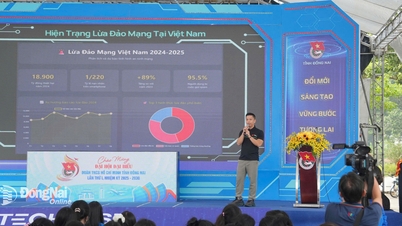 |
The “blue-green” color has a saturation far beyond anything the human eye has ever seen. They call this color “olo.” Photo: Deposit Photo . |
An invisible turquoise color, never before seen in any color palette, has just been recorded as visible, but only if a laser is shined directly into the human retina.
According to a paper published in the journal Science Advances , the research team has successfully helped the first five people in human history see a color beyond the normal visual spectrum.
Participants, including the scientists themselves, saw a “blue-green” color. The color was so saturated that the human brain had never received a similar signal to reproduce it. They called it “olo.”
According to Scientific American , humans are typically able to distinguish nearly 10 million colors, thanks to three types of cone cells in the retina. S (short) cones perceive short-wavelength light like blue. M (medium) cones respond to medium wavelengths like green, and L (long) cones respond to long wavelengths like red. These three signals are transmitted to the brain to form the rich color system we experience every day.
However, these cones have overlapping response zones. According to Professor Ren Ng, an electrical engineering and computer science major at the University of California, Berkeley, no light in nature activates only M cones without also stimulating S or L cones.
This means that under normal conditions, the human eye never sends signals from the M cones alone to the brain. This is a fundamental limitation of the human visual system.
 |
When white light was added to the olo, which diluted the color, participants saw that the new color matched teal. Photo: Science Advances. |
To overcome that limit, Ren Ng's team developed a special technique they call “Oz”, inspired by the Jade Castle in the novel The Wizard of Oz .
The team mapped the human retina in detail to determine whether each cone cell was an S, M, or L type. They then used an extremely precise laser system to shine light only on the pre-positioned M cells, deliberately avoiding activating the other two types.
However, the technique is not user-friendly. Participants sit in a dark room, biting a bar to keep their head and eyes completely still, while a series of devices such as mirrors, deformable mirrors, modulators and light sensors operate around them.
Of the five participants, three are co-authors of the study, including Ren Ng himself. The other two are researchers at the University of Washington. They were not told in advance about the true purpose of the experiment.
According to the team, olo is “a blue-green of unimaginable saturation.” It’s unlike any color that can be displayed on a computer screen. The closest possible color is teal, represented by the hex code #00ffcc.
If you want to visualize olo, imagine you’re tweaking a teal color on your computer by keeping the hue constant, gradually increasing the saturation. At a certain point, the screen can’t display it anymore. But you keep increasing the saturation beyond any natural limit, and that’s where olo comes in. The human eye can only perceive it with laser light finely tuned to each cell.
In the short term, the Oz technique can help people who are born colorblind experience red and green for the first time. However, it is not a cure, but a temporary visual experience. “The Oz effect is transient. It is not permanent,” Ng said.
Source: https://znews.vn/chi-5-nguoi-tung-nhin-thay-mau-sac-bat-kha-thi-nay-post1547284.html





![[Photo] Enjoy the Liuyang Fireworks Festival in Hunan, China](https://vphoto.vietnam.vn/thumb/1200x675/vietnam/resource/IMAGE/2025/10/26/1761463428882_ndo_br_02-1-my-1-jpg.webp)
![[Photo] General Secretary To Lam received the delegation attending the international conference on Vietnam studies](https://vphoto.vietnam.vn/thumb/1200x675/vietnam/resource/IMAGE/2025/10/26/1761456527874_a1-bnd-5260-7947-jpg.webp)
![[Photo] Nhan Dan Newspaper displays and solicits comments on the Draft Documents of the 14th National Party Congress](https://vphoto.vietnam.vn/thumb/1200x675/vietnam/resource/IMAGE/2025/10/26/1761470328996_ndo_br_bao-long-171-8916-jpg.webp)




















![[Photo] Prime Minister Pham Minh Chinh attends the opening of the 47th ASEAN Summit](https://vphoto.vietnam.vn/thumb/1200x675/vietnam/resource/IMAGE/2025/10/26/1761452925332_c2a-jpg.webp)











































































Comment (0)